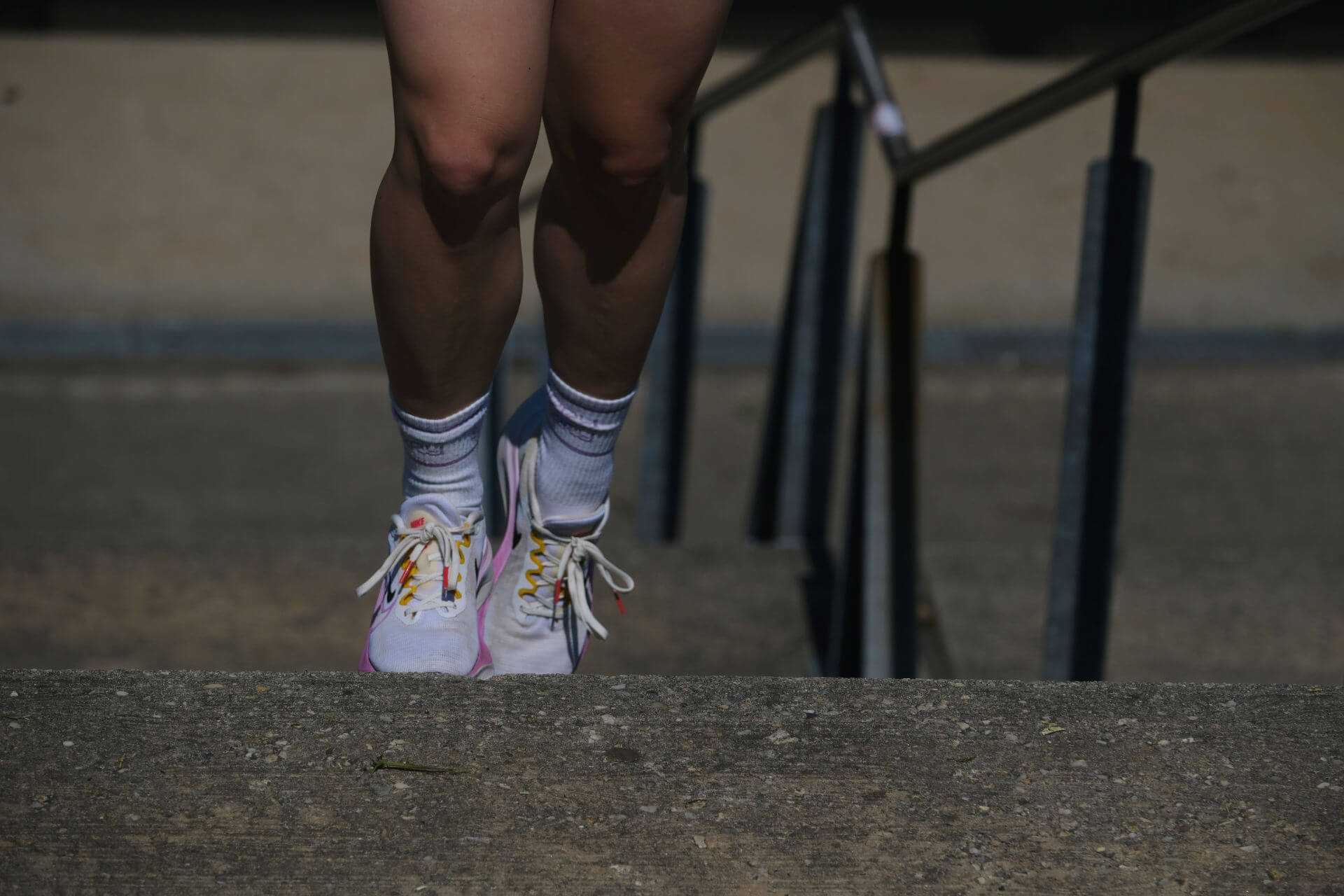Startseite / When Every Step Feels Like a Sting: How to Effectively Prevent Plantar Fasciopathy in Runners

Heel pain while running? Part 2 of our series on Tendoninjuries in running. In this guide, you’ll learn why the plantar fascia is often overloaded—and how a 7-minute routine can sustainably strengthen it.
Do you know the feeling of getting out of bed in the morning and it feels like stepping on a
In Part 2 of our series on tendon injuries in runners, we take a closer look at this important, often underestimated structure on the bottom of your foot – and show you how to get it back in the game with targeted training.
The plantar fascia is not a muscle but a collagen-rich sheet of connective tissue (aponeurosis) that stretches from the heel bone to the base of the toes. It acts like an elastic tension cable, stabilizing the arch of the foot, storing impact energy, and transmitting force with every step.
While running, it must absorb up to 2.5 times your body weight per foot strike (1) – an enormous job for a seemingly inconspicuous structure.
Problems arise when micro-injuries and insufficient recovery lead to what’s known as plantar fasciopathy: a structurally altered irritation, usually at the tendon’s origin on the heel bone – typically felt in the morning or after long runs.
Many risk factors are modifiable – which is exactly where prevention comes into play. The most important ones according to current research (2):
Weak foot muscles: Especially the small intrinsic muscles like the flexor hallucis brevis help offload the fascia – if trained (2,4).
Collapsed arch / overpronation: Increases strain on the fascia with every step (2).
Poor sleep: Sounds trivial but is essential. Deep sleep promotes growth hormone release, which supports collagen synthesis (3).
BMI over 27: Even in active individuals, a relevant overload risk factor (2).
Sudden training increases or rapid switch to barefoot/minimal shoes: The fascia needs time to adapt (2).
Restricted mobility: Limited dorsiflexion in the toe joints or ankle, or shortened calf muscles, can negatively impact the fascia (2).
Plantar fasciopathy is common – but it’s not the only cause of plantar heel pain. Other diagnoses like Baxter’s nerve entrapment, fat pad atrophy, or a heel spur can cause similar symptoms. A proper medical diagnosis is therefore essential before starting any treatment.
The good news: plantar fasciopathy is treatable. The key is not just rest – but targeted training. According to current evidence, the following interventions have proven particularly effective:
1. Heavy-Slow Resistance Training (HSR)
Slow, controlled strengthening exercises for the calf muscles – especially with a bent knee and extended big toe – led to significant improvements in foot function (up to 33 points on the Foot Function Index) in two randomized controlled trials (5,6).
Important: Slow repetitions (3–4 seconds), 6–10 reps, 2–3×/week.
2. Plantar Fascia Stretching (Windlass Stretch)
Daily, especially in the morning: In a seated position, pull the toes – especially the big toe – toward the shin. Studies showed significant pain reduction within 4 weeks (7,11).
3. Foot Muscle Training
Actively lift the foot arch – without curling the toes. An RCT showed significant pain reduction and improved foot function after just 12 weeks (4).
A stronger, more stable foot relieves strain on the fascia. Especially noteworthy is the improvement in proprioception – better awareness and control of the foot may prevent overload patterns. A highly useful approach from a preventive standpoint.
4. Night Splints
Only for symptoms lasting longer than six months. A meta-analysis showed moderate symptom improvement in chronic cases (8,13).
5. Sleep & Nutrition – The Underrated Gamechangers
Sufficient deep sleep supports collagen synthesis and tissue healing (3,9). In addition, collagen hydrolysate taken with vitamin C 45 minutes before training may increase tendon stiffness by up to 15% within three months (10).
However, these should be seen as adjunct strategies: they don’t replace training but optimize recovery conditions.
5. Insoles: Transitional Support – But No Substitute for Training
Orthopedic insoles can help offload the foot – especially during acute flare-ups or prolonged standing throughout the day. However, they only provide short-term pain relief (14).
In the long run, they are no replacement for active training.
That’s why the rule is: insoles should be used as a temporary measure only – and always combined with targeted strength and functional training.
Want to care for your feet daily – without spending much time? Then this is the routine for you.
Prerequisite: no acute pain >3/10 and prior medical clearance.
Exercise | Duration | Purpose |
Windlass Stretch | 1 min | Stretching the plantar fascia |
Foot Core (lift big toe actively) | 1 min | Activate intrinsic foot muscles |
Tibialis Posterior Raises | 2 × 30 sec | Midfoot stability |
Extended Toe Heel Raises – HSR | 2 × 10 reps | Strength & controlled load |
Short Foot + Single Leg Balance | 1 min | Proprioception & arch stability |
Total duration: 7 minutes – ideal in the morning or before running.
Plantar fasciopathy is not a “damaged” tissue that must be avoided, but a structure that adapts to controlled tension.
This is where modern physiotherapy steps in: instead of just taping or passive treatments, we need targeted load management, functional strength work, and an active role for the runner in their own recovery.
The research is clear: Those who train rather than rest return to running faster – often with improved foot strength and a more economical running style.
What do you think about this holistic training approach for heel pain?
Feel free to share this article on social media – and let us know your opinion.
We look forward to your feedback.